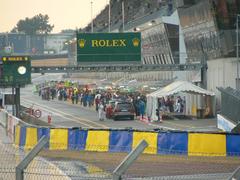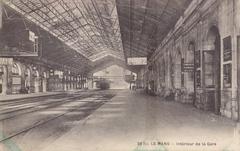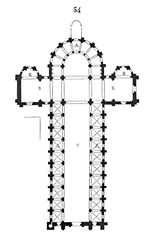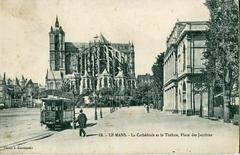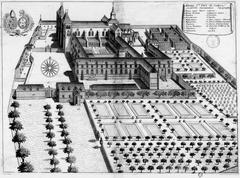
Cité Plantagenêt Le Mans: Complete Guide to Visiting Hours, Tickets, and Travel
Date: 04/07/2025
Introduction
Situated at the heart of Le Mans, France, the Cité Plantagenêt—known also as Le Vieux Mans or Plantagenet City—is a remarkable medieval district offering more than 2,000 years of layered history. From its origins as a fortified Gallo-Roman settlement with some of Europe’s best-preserved Roman walls, through its medieval prosperity as the birthplace of Henry II and the cradle of the Plantagenet dynasty, to its current status as a vibrant living heritage site, the Cité Plantagenêt encapsulates centuries of architectural, cultural, and urban evolution. Today, visitors can explore a tapestry of cobbled streets, timber-framed houses, grand Romanesque and Gothic landmarks like the Saint-Julien Cathedral, and Renaissance mansions—all set within ancient ramparts that have stood since the 3rd century CE. The district is further enlivened by local artisans, lively markets, and events such as the celebrated “Nuit des Chimères” light festival.
This comprehensive guide provides essential information on visiting hours, ticketing, accessibility, travel tips, and highlights to ensure you experience the best of this UNESCO World Heritage candidate (Sarthe Tourisme; Le Mans Tourisme; The Crazy Tourist).
Table of Contents
- Historical Overview
- Architectural Highlights
- Cultural Life and Events
- Visitor Information
- Frequently Asked Questions (FAQ)
- Conclusion
- References
Historical Overview
Origins and Roman Foundations
Human settlement in the area dates back over 7,000 years, but the urban fabric of Cité Plantagenêt was truly shaped during the Roman era. By the 3rd century CE, Le Mans—then Vindinum—was an important Gallo-Roman town. To guard against invasions, the Romans built a massive enceinte (city wall) from 270 to 310 CE. Stretching more than a kilometer and punctuated by towers, this wall is among the best-preserved in Europe, its polychrome brickwork and geometric patterns a testament to Roman engineering (Sarthe Tourisme).
Medieval Development and Plantagenet Dynasty
After the fall of Rome, Le Mans became a strategic stronghold for Frankish, Breton, and Norman powers. By the 10th century, it was the seat of the Counts of Maine and later the birthplace of Henry II (1133), the first Plantagenet King of England. The Plantagenet dynasty profoundly shaped the district’s growth, with the old town’s winding streets, timber-framed houses, and notable landmarks like the Royal Abbey of Épau—founded by Queen Bérengère of Navarre, Richard the Lionheart’s widow (Le Mans Tourisme; France Rent).
Architectural Highlights
Saint-Julien Cathedral
The Cathedral of Saint-Julien dominates the Cité Plantagenêt with its blend of Romanesque and Gothic architecture. Built from the 11th to the 13th centuries, it features a robust Romanesque nave and an Angevin Gothic choir, decorated with intricate stained glass—including the world’s oldest “Ascension” window still in situ—and the celebrated “Chapel of the Angels” with 47 painted musical angels (Sarthe Tourisme).
- Hours: Open daily 9:00 AM–6:00 PM; free entry, donations welcome.
- Highlights: Romanesque nave, Gothic choir, medieval stained glass, and the legendary Pierre Saint-Julien menhir.
Gallo-Roman Walls
Encircling much of the historic core, the 3rd-century Gallo-Roman walls are a marvel of ancient engineering. About 500 meters survive today, punctuated by towers and decorated with red brick and Roussard stone friezes. They symbolize Le Mans’ autonomy and now serve as the backdrop for cultural events like the Nuit des Chimères (lemans-countryclub.com).
Timber-Framed Houses and Renaissance Mansions
The district’s labyrinth of cobbled streets—Rue de la Reine Bérengère, Grande Rue, and Rue de Vaux—features half-timbered houses from the 14th–16th centuries and ornate Renaissance mansions like Hôtel de Clairaulnay and Hôtel Nepveu de Rouillon. Maison de la Reine Bérengère, now a museum, is a landmark ensemble of 15th-century houses (francethisway.com; thecrazytourist.com).
Cultural Life and Events
Nuit des Chimères
Each summer, the “Nuit des Chimères” transforms the district into a magical canvas, with light projections illuminating the cathedral, Roman walls, and historic facades. The event is free, typically held mid-July through August (Sarthe Tourisme).
Museums and Interpretation Centers
- Musée de la Reine Bérengère: Located in medieval houses, this museum explores the city’s history and the Plantagenet dynasty.
- Carré Plantagenêt – Jean-Claude Boulard Museum: Traces Le Mans from prehistory to the Middle Ages with archaeological treasures.
Both museums are generally open Tuesday–Sunday, 10:00 AM–6:00 PM; tickets range from €5–€8 (maryannesfrance.com).
Visitor Information
Visiting Hours and Tickets
- Cité Plantagenêt District: Open 24/7, no entrance fee.
- Cathedral of Saint-Julien: Daily, 9:00 AM–6:00 PM, free entry.
- Royal Abbey of Épau: Tuesday–Sunday, 10:00 AM–5:30 PM, approx. €7 adults, €4 concessions.
- Museums: Generally 10:00 AM–6:00 PM; check official sites for updates.
- Guided Tours: The Le Mans Tourist Office provides themed tours in multiple languages, €8–€15 per person. Book in advance during peak seasons (Le Mans Tourist Office).
Accessibility and Travel Tips
- Getting There: From Gare du Mans, the Cité is a 15–20 min walk or short tram ride (T1, stop at “Eperon-Cité Plantagenêt”).
- Parking: Public lots at République and Jacobins; area is mostly pedestrianized (LeShuttle Guide).
- Mobility: Streets are cobbled and sometimes steep; comfortable shoes recommended. Accessibility is improving but some areas remain challenging.
- Maps and Signage: Free multilingual maps at Maison du Pilier-Rouge (43 Grande Rue). Key historical sites are signposted.
- Dining: Local specialties like rillettes and Loire wines are available at cafes and bistros in Place Saint-Pierre and Place des Jacobins.
- Accommodation: Numerous options within a 10-minute walk of the district, from boutique hotels to guesthouses (source).
- Best Times to Visit: Spring through early autumn for events and mild weather; mornings and weekdays are quieter. European Heritage Days in September open private mansions to the public.
Frequently Asked Questions (FAQ)
Q: Is there an entrance fee to the Cité Plantagenêt?
A: No, the district is open year-round and free to explore. Museums and tours require tickets.
Q: Are guided tours available?
A: Yes, through the Le Mans Tourist Office. Pre-booking is recommended during summer.
Q: Is the area accessible for people with mobility issues?
A: Main sites offer accessible routes, but cobbled streets and slopes can be challenging. Contact the Tourist Office for advice.
Q: What are the main events?
A: The Nuit des Chimères light festival (summer) and European Heritage Days (September) are highlights.
Q: Where can I get more information?
A: At the Maison du Pilier-Rouge (43 Grande Rue) or official tourism sites.
Conclusion
Cité Plantagenêt is a living historical masterpiece, seamlessly blending ancient walls, medieval streets, and vibrant cultural life. Whether you are captivated by architecture, fascinated by history, or seeking immersive local experiences, this district promises a rewarding journey through centuries of French heritage. For an optimal visit, check official resources for up-to-date opening hours, ticketing, and accessibility information. Don’t forget to download the Audiala app for immersive audio guides, explore related posts on our website, and follow us on social media for the latest updates.















